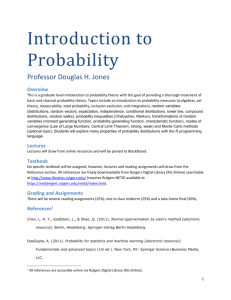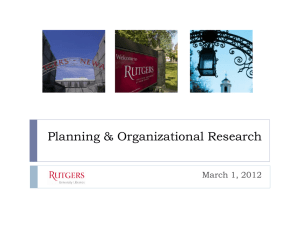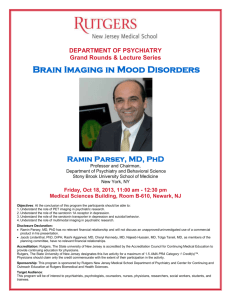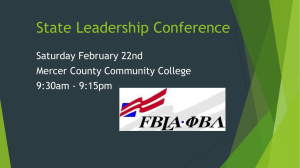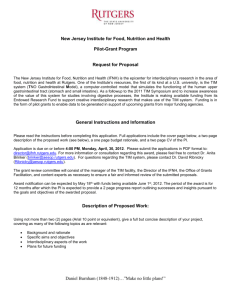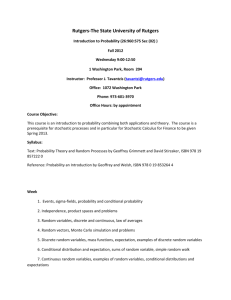Kooksang Moon`s CV - Computer Science
advertisement
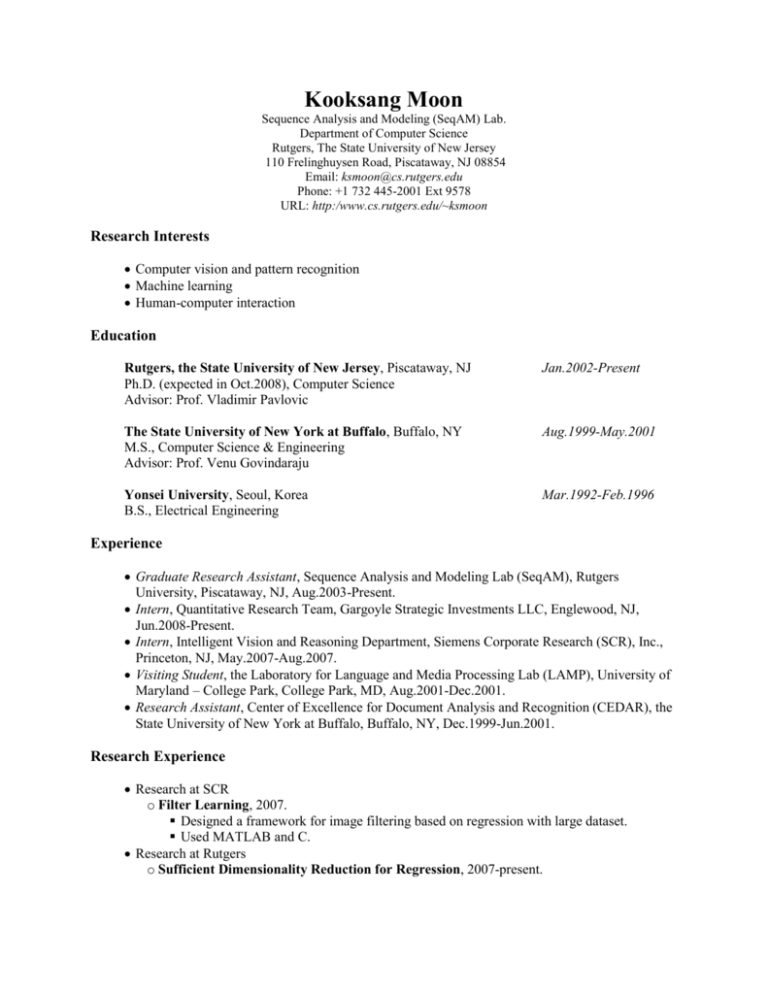
Kooksang Moon Sequence Analysis and Modeling (SeqAM) Lab. Department of Computer Science Rutgers, The State University of New Jersey 110 Frelinghuysen Road, Piscataway, NJ 08854 Email: ksmoon@cs.rutgers.edu Phone: +1 732 445-2001 Ext 9578 URL: http:/www.cs.rutgers.edu/~ksmoon Research Interests Computer vision and pattern recognition Machine learning Human-computer interaction Education Rutgers, the State University of New Jersey, Piscataway, NJ Ph.D. (expected in Oct.2008), Computer Science Advisor: Prof. Vladimir Pavlovic Jan.2002-Present The State University of New York at Buffalo, Buffalo, NY M.S., Computer Science & Engineering Advisor: Prof. Venu Govindaraju Aug.1999-May.2001 Yonsei University, Seoul, Korea B.S., Electrical Engineering Mar.1992-Feb.1996 Experience Graduate Research Assistant, Sequence Analysis and Modeling Lab (SeqAM), Rutgers University, Piscataway, NJ, Aug.2003-Present. Intern, Quantitative Research Team, Gargoyle Strategic Investments LLC, Englewood, NJ, Jun.2008-Present. Intern, Intelligent Vision and Reasoning Department, Siemens Corporate Research (SCR), Inc., Princeton, NJ, May.2007-Aug.2007. Visiting Student, the Laboratory for Language and Media Processing Lab (LAMP), University of Maryland – College Park, College Park, MD, Aug.2001-Dec.2001. Research Assistant, Center of Excellence for Document Analysis and Recognition (CEDAR), the State University of New York at Buffalo, Buffalo, NY, Dec.1999-Jun.2001. Research Experience Research at SCR o Filter Learning, 2007. Designed a framework for image filtering based on regression with large dataset. Used MATLAB and C. Research at Rutgers o Sufficient Dimensionality Reduction for Regression, 2007-present. Kooksang Moon 2 Developing a kernel dimensionality reduction method preserving information relevant for a general nonlinear regression. The approach called Gaussian process manifold kernel dimensional reduction (GPMKDR) is induced by reformulating the manifold kernel dimensional reduction in the Gaussian process framework and the solution is given by the maximum eigenvalue-eigenvector solution to a kernelized problem. Using MATLAB. o Monocular 3D Human Motion Tracking, 2006-2007. Developed the statistical framework for modeling and tracking of the 3D human figure motion from monocular video which utilizes the dynamic probabilistic latent semantic analysis (DPLSA) model describing the mapping of image features to 3D human pose estimates via latent variable. Used MATLAB. o Estimating and Recognizing 3D Articulated Motion via Uncalibrated Cameras, 20032006. Worked as the graduate research assistant for developing human motion tracking system with monocular camera on a NSF funded project. Developed the probabilistic framework for modeling and tracking of the 3D human figure motion from a sequence of monocular images with subspace embedding, in which the dynamics in latent space is utilized using Marginal Auto-Regressive (MAR) model and the embedding model is defined using Gaussian process latent variable model (GPLVM). Developed the 2D-based articulated object tracking method which utilizes a layered representation approximating the true 3D link relationships and a robust parametric statistical representation of the link appearance. Used MATLAB and C. o Sensor, Database and Algorithm Development for Face and Gait-based Deception Analysis, 2005-2006. Worked as the graduate research assistant for developing gait-based deception analysis system on a HSARPA (Homeland Security) funded project. Designed shoulder tracking module detecting the texture boundary of shoulder and analyzing the shoulder movement with a Hidden Markov model. Used MATLAB and C++ on MS Visual Studio. Research at LAMP o Tracking text in digital video, 2001. Designed the edge-based text detection method using morphology-based operation and density map to supplement the drawback of texture-based text detection. Used C on Solaris. Research at CEDAR o Learning binary feature similarity measure for OCR using genetic algorithm, 2001. Developed the new distance measure for Gradient, Structural, and Concavity (GSC) binary features, in which GSC features are regarded as a compounded feature with different weights representing the various effects of individual feature groups and the optimal weights can be learned effectively through Genetic algorithm. Used MATLAB and C on Solaris. o Sequential pattern mining in text database, 2001 Implemented the system to discover the trend in the database of research paper abstracts by using classical sequential pattern mining technique with an efficient keyword extraction method. Used Perl on Solaris. o United Kingdom Address Interpretation (UKAI), 1999-2001. Kooksang Moon 3 Worked as the research assistant for grafting the Handwritten Address Interpretation (HWAI) system to read handwritten addresses for UK’s Royal Mail on a LockheedMartin funded project. Designed stamp mark removal algorithm using density histogram in text line segmentation module. Designed underline detection and removal module for mail piece image preprocessing by utilizing morphology operation and modified Hough transform. Used C on MS Visual Studio. Publications 1. K. Moon and V. Pavlovic, “Gaussian Process Manifold Kernel Dimensionality Reduction,” submitted to Conference, 2008. 2. K. Moon and V. Pavlovic, “Monocular 3D Human Motion Tracking Using Dynamic Probabilistic Latent Semantic Analysis,” Proc. Canadian conference on Compute and Robot Vision, Ontario, Canada, 2008. 3. K. Moon and V. Pavlovic, “Graphical Models for Human Motion Modeling,” book chapter in Human Motion Capture: Modeling, Analysis, Animation, Metaxas, Rosenhahn and Kleete Eds., Springer, 2007 4. K. Moon and V. Pavlovic, “Impact of Dynamics on Subspace Embedding and Tracking of Sequences,” Proc. IEEE Conference on Computer Vision and Pattern Recognition (CVPR), New York, USA, 2006. 5. K. Moon and V. Pavlovic, “Robust Tracking of Articulated Layers,” IEEE International Workshop on Vision for HCI in conjunction with CVPR, San Diego, USA, 2005. Professional Activities and Affiliations Reviewer for IEEE ICPR ’04, ICMI ’04, IEEE ICCV ’05, ECCV ’06, IEEE ICPR ’06, IEEE ICCV ’07, CVPR’08, CVIU (Computer Vision and Image Understanding) Journal. Member of IEEE, 1999-Present. Member of Korean Science & Engineering Association (KSEA), 2002-Present Teaching Experience Introduction to Computer Science, undergraduate course, Fall, 2006-Spring, 2008. o Teaching a recitation class on Java programming language. Technical Skills Language C/C++, MATLAB, Java, Perl, VBA, HTML, Pascal Tools MS Visual Studio, MS Office, Eclipse, Alias Maya, Oracle, Macromedia Studio Operating System MS Windows 98/2000/NT/XP/Vista, Solaris, Linux References Kooksang Moon 4 Dr. Vladimir Pavlovic Assistant Professor Dept. of Computer Science Rutgers University 110 Frelinghuysen Road Piscataway, NJ 08854 Email: vladimir@cs.rutgers.edu Phone: +1 732 445 2654 Dr. Ilya Muchnik Research Scientist DIMACS Rutgers University P.O. Box 8018 Piscataway, NJ 08855 Email: muchnik@dimacs.rutgers.edu Phone: +1 732 445 0073 Dr. Greg Slabaugh Research Scientist Intelligent Vision and Reasoning Dept. Siemens Corporate Research 755 College Road East Princeton, NJ 08540 Email: greg.slabaugh@siemens.com Phone: +1 609 734 3350 Dr. Sung-Hyuk Cha Assistant Professor School of Computer Sc. & Information Sys. Pace University 861 Bedford Road Pleasantville, NJ 10570 Email: scha@pace.edu Phone: +1 914 773 3891

